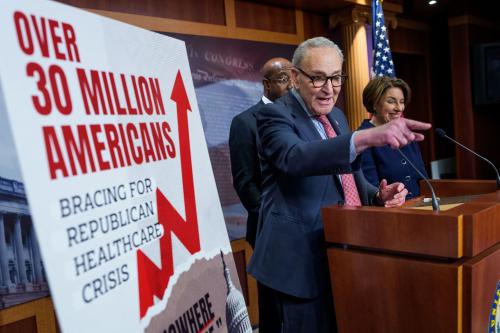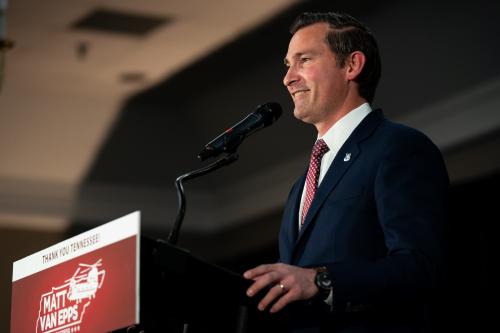“I view it as a, in a sense, a wartime president”—Donald Trump March 18, 2020
Upon becoming prime minister of Great Britain in May 1940, Winston Churchill confronted the reality of a German airborne assault and a shortage of the tools to oppose it. In January 2020, President Donald Trump also faced an airborne assault—not from bombers but from a virus. Trump too was without sufficient tools. The glaring difference in their responses focuses our attention on what it really means to be a wartime leader.
Churchill’s shortage was fighter aircraft, and he acted immediately upon becoming prime minister to attack his shortage. Trump’s shortage was coronavirus test kits, and given ample advance warning, he dithered. Churchill moved to manage the problem, while Trump moved to manage the narrative.
In his masterful new book, The Splendid and the Vile, author Erik Larson chronicles Churchill’s response to the fighter aircraft shortage. The brand new prime minister embraced the problem, recognized the importance of its remission, and brought in a tough-as-nails son of a bitch to knock heads together and put things right.
On his first day as prime minister, Churchill created a new cabinet office, the Ministry of Aircraft Production, to focus the government’s attention on the production of needed airframes and engines. To head that office he named Max Aitken, Lord Beaverbrook, “a man who drew controversy the way a steeple draws lightning.”[1]
Immediately, Beaverbrook and his team put in 12-hour days, seven days a week, to push and prod what had been a peacetime pace of production to war footing. Beaverbrook stepped on toes, engaged in turf battles, and fought with his client, the Air Ministry, incessantly—and fighter production rose in the nick of time. Six weeks after naming Beaverbrook, weekly aircraft production had increased by almost 50 percent.[2] When the Battle of Britain began two months to the day from Churchill becoming prime minister, the small fighter fleet was already being reinforced with new planes coming off the production lines at a record pace.
“Action this day” Churchill used to put on memos to his officials. The lack of such an action imperative is one of the factors differentiating Donald Trump’s leadership during the COVID crisis.
“U.S. intelligence reports from January and February warned about a likely pandemic,” The Washington Post headlined. However, President Trump “played down the threat and failed to take action that might have slowed the spread of the pathogen.” On January 21 the first domestic case of the virus was reported. The next day the president told an interviewer, “we have it totally under control. It’s—going to be just fine.”
Only five days earlier, the World Health Organization (WHO) adopted a test to determine if things were “just fine.” Yet, as Dr. Ashish Jha, director of the Harvard Global Health Institute observed, “the messaging from the White House was ‘this is not a big deal, this is no worse than the flu.’”
At a March 6 press event following his tour of the Centers for Disease Control (CDC)—wearing a bright red “Keep America Great” campaign baseball cap—President Trump promised, “anyone who wants a test can get a test,” The facts, however, were far different. According to The Associated Press, “CDC and state health labs processed about 25,200 COVID-19 tests in the following seven days.”
In 1940, the Air Ministry was telling the British government they were doing everything possible to ramp up fighter production. On behalf of Churchill, Beaverbrook disrupted the “fusty practices of a peacetime bureaucracy.”[3] In January 2020, the Centers for Disease Control sounded a bit like the Air Ministry when it reported it was doing everything possible to develop its own COVID-19 test. However, as a New York Times’ investigation found, “Without high-level interest—or demands for action—the testing issue festered.”
The action imperative cannot be replaced by spinning the narrative. On May 19, 1940—nine days after becoming prime minister and acting to create the new ministry—Churchill spoke directly to the British people. “It would be foolish to disguise the gravity of the hour,” he told the nation. On February 27, 2020—over a month after the first COVID-19 case was reported—President Trump told the nation, “It’s going to disappear. One day, it’s like a miracle. It will disappear.”
Leadership is something that is exercised and recognized, not self-declared. On March 17—two-and-a-half months after first being told of the virus—President Trump lamented, “We’ve done a fantastic job, but it hasn’t been appreciated.” When asked on April 6 about continued delays in testing, he blasted the Fox News reporter, angrily responding, “You should say ‘congratulations, great job.’”
Most of all, leadership is about responsibility. Churchill knew the buck stopped with him. On March 13, after announcing a COVID-19 national emergency, President Trump was asked whether he takes responsibility for the lack of availability in test kits. “No. I don’t take responsibility at all” was his response.
A week later, asked if he had spoken to any of his predecessors about the challenge, Trump responded, he doesn’t think he’s “going to learn much” from them. Then he went on to add, “I think we’re doing an incredible job.”
An observation attributed to Churchill describes the leadership difference we are witnessing: “To each there comes in their lifetime a special moment when they are figuratively tapped on the shoulder and offered the chance to do a very special thing, unique to them and fitted to their talents. What a tragedy if that moment finds them unprepared or unqualified for that which could have been their finest hour.”
[1] Erik Larson, The Splendid and the Vile, Crown, p.41
[2] Ibid, p. 90
[3] Ibid, p. 41
The Brookings Institution is committed to quality, independence, and impact.
We are supported by a diverse array of funders. In line with our values and policies, each Brookings publication represents the sole views of its author(s).





Commentary
Wartime leadership then and now
April 9, 2020